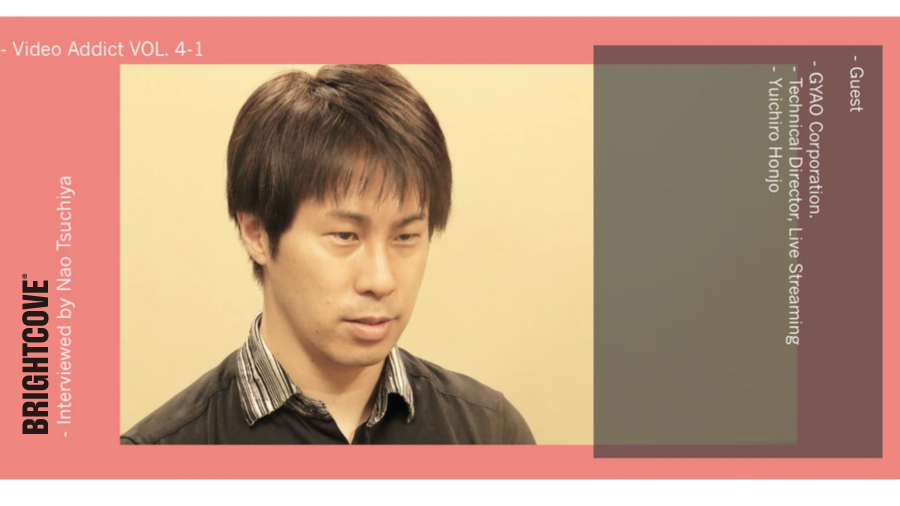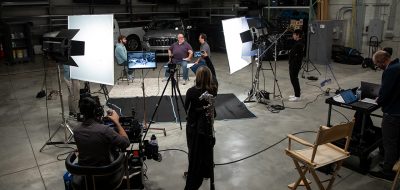In Video Addict Vol.4, we will be looking at GYAO Corporation (hereafter GYAO), which operates the free video distribution service GYAO! in collaboration with Yahoo Japan Corporation. GYAO has a long history in the online video distribution industry, starting with the launch of “GyaO PC TV” in April 2005. At the time, the service was talked about for its extensive program lineup and free service, and within a year of its launch, it had over 10 million members. Even after it was integrated with Yahoo! Video in 2009, it has continued to deliver highly original content. This time, we spoke with Mr. Honjo of GYAO’s Innovation Promotion Office and Content Business Division, who has been involved in various video distribution services in the past.
## Starting a web production company while still at university
**Brightcove (BC) Tsuchiya** Thank you for speaking at PLAY TOKYO 2018. As you told us then, you have a diverse background. Could you tell us about your career again?
**Mr. Honjo**: Yes. First of all, I started out in 1999 by setting up a web production company with some friends. I was working part-time for an internet provider in Fukuoka, and I started up a business with some of my part-time colleagues while I was still at university. Unfortunately, this company didn’t last very long.
**Mr. Tsuchiya**: Can you tell us a little about the background to the difficulties you had with the business? It was 1999, the so-called IT bubble era, right?
**GYAO Honjo** That’s right. At the time, even large companies in Fukuoka didn’t have their own domain names, so we had to explain to them what a domain name was. The importance of companies having websites was still not well recognized in Fukuoka compared to Tokyo, so it was difficult to get business.
However, apart from that company, when I was a student I set up a website that summarized university festivals. There are beauty contests at university festivals, and the idea was to film the beauty contest videos from around the country and publish them online.
**BC Tsuchiya** That’s amazing for a video portal site at the time. What was the video format at the time?
**Mr. Honjo of GYAO** We used Real (an internet streaming technology developed by Real Networks). I would take my own camera to the venue, film it, and post it on the website. That was how I got involved in internet video. After that, I closed the company I had started and moved to an internet service provider I knew, where I worked as a network engineer for two years. In 2001, I moved to Tokyo when I took up a position at another venture company I knew. This venture company was affiliated with the company Cable Broadband Networks (now USEN), so I also worked as a backend engineer for them.
## In charge of live broadcasts of the SoftBank Hawks games because he is from Fukuoka
**BC Tsuchiya** After that, you moved to SoftBank BB Corp. in 2004.
**GYAO Honjo** Yes. At the time, USEN was considering launching “PC TV GyaO”, and I was scheduled to be assigned to that project, but before I was assigned, I moved to SoftBank BB Corp.
**BC Tsuchiya** That’s interesting (lol). After all, you’re working at GYAO now.
**GYAO Honjo** That’s right (laughs). After that, TV Bank Corporation (hereafter, TV Bank) was established within the SoftBank Group, and I transferred to TV Bank. This was the start of my full-time involvement with video. In 2005, the Fukuoka SoftBank Hawks baseball team was launched, and it was decided that live broadcasts of the games would be streamed online. I was assigned to this project because I was from Fukuoka (laughs).
**BC Tsuchiya** It’s interesting that you were assigned to this project because you were from Fukuoka. What kind of work did you do specifically?
**GYAO Honjo** I was in charge of designing and operating the infrastructure and servers. It was around the time when ADSL was becoming widespread, but we had no knowledge of how much bandwidth was needed for distribution, so we had to adjust it as we went along. Also, even though it was over the internet, it was a service that was similar to broadcasting, so we had to work hard to deliver a service that didn’t allow even a momentary interruption.
## We were asked to install 100 cameras.
**BC Tsuchiya** What was the picture quality (resolution) and bit rate like at the time?
**GYAO Honjo** I think the highest picture quality was around 360p at 768kbps.
**BC Tsuchiya** 768kbps was a very high quality at the time.
**GYAO Honjo** The live broadcasts of the Fukuoka SoftBank Hawks were interesting, and in addition to the switching out images on TV, they were also able to deliver images from 30 fixed cameras from various angles. President Son asked us to install 100 cameras (lol), but somehow we managed to get 30 cameras and users were able to choose their favorite angle. Here, we could see from the number of accesses which angles were popular and which were not, and it was interesting from the perspective of content creation.
**BC Tsuchiya** It’s true that multi-angle videos became popular. I remember the case of multi-angle videos in racing sports from my previous job. In 2011, you moved to Ustream Asia (TV Bank invested 60%), which was a group company. Just looking back on your career so far, it seems like you were the contractor for setting up video distribution services. Ustream was also gaining a lot of momentum at this time. Although there were also media companies using it, it was this service that made it possible for ordinary people to easily start live streaming on the web.
**Mr. Honjo** I was in charge of the back-end side, but Ustream was a UGC and technical service. For this reason, it was necessary to educate users about the technical side of things. I was in charge of activities to educate users, such as “this is how you should use it” and “a new service has started”.
**BC Tsuchiya** After that, he was transferred to SoftBank Telecom, where he was involved in international video transmission services for BtoB, before moving to GYAO.
**GYAO Honjo** I was transferred around within the SoftBank Group for about 10 years, but I joined GYAO in the form of a job change. My main job is directing live broadcasts. I also work as a director of service development, and I am also in charge of technical direction related to GYAO services.
That concludes Part 1. Honjo-san’s career is so interesting that it could be said to be the history of internet video distribution in Japan. In Part 2 (https://www.brightcove.com/ja/resources/blog/video-addict-vol4-gyao-2), he talks about GYAO!’s initiatives regarding live streaming and the things he values when it comes to content.




